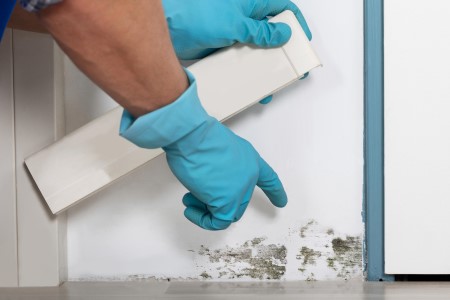Mold Remediation
You’ve identified the problem, now what?
Anyone can remove mold, but it takes a mold remediation professional to do it right. If mold remediation is done improperly, it can easily do more harm than good. Our technicians will develop a mold remediation plan specific for your needs, ensuring your problem is remedied quickly and effectively. Our technicians are certified in mold remediation and receive extensive ongoing education and training.
Mid-West Restoration leads the industry with our 8 step mold remediation process.
1. Prepare the site.
2. Contain the area.
3. Achieve negative air pressure.
4. Remove damaged materials.
5. HEPA vacuum and clean-up.
6. Apply antimicrobial treatment.
7. Conduct clearance testing.
8. Remove contaminant.
Properties where fires have occurred are also at increased risk.
One major concern is the permanent elimination of the entire toxic mold from the structure. Incidents of future reoccurrence of Stachbotrys, a common form of toxic mold, are disturbingly frequent. Therefore, great care must be exercised to remove and dispose of any and all products that have been contaminated by the toxic mold – a recommendation supported by many states’ Departments of Health.
Another concern is that people react differently to toxic mold exposure. Certain individuals, especially children, exhibit severe reactions which include damage to lung tissue, memory loss, and even death. Other persons exhibit less severe symptoms and fewer long-term consequences when exposed. Severity of symptoms and effects may depend on the individuals’ chemical sensitivity, genetic disposition and health history (allergies, asthma, smoking, etc.). For some, the exposure to the toxic mold spores may be classified as a “health risk”, while it is a true “health hazard” (potential for loss of life or quality of life) for others.

Mold is a type of fungus, and is the decomposer of dead organic material such as leaves, wood and plants. The spores and hair-like bodies of individual mold colonies are too small for us to see, but when a significant amount of mold is growing on a surface, it often appears black or green. If mold is growing behind vinyl wallpaper, colorful pink or purple splotches may appear. Mold can cause serious health problems, as well as damage and destruction of building materials, and should be treated as soon as possible.
Allergenic Molds
Allergenic molds do not usually produce life-threatening health effects and are most likely to affect those who are already allergic or asthmatic. The human system responses to allergenic molds tend to be relatively mild, typically producing scratchy throats, eye and nose irritations and rashes.
Pathogenic Molds
Pathogenic molds usually produce some type of infection. They can cause serious health effects in persons with suppressed immune systems.
Toxigenic Molds
Mycotoxins can cause serious health effects in all segments of the population. These agents have toxic effects ranging from short-term irritation to immunosuppression and possibly cancer. The environmental risk of toxic mold may be one of the next major real estate “due diligence” concerns, especially in property development areas where flooding has occurred. This not only includes residential and commercial flood areas, but also minor water releases due to plumbing failures, condensation, and residential water leaks.
The Problem with Bleach
Many families believe that chlorine bleach is the most effective mold remover. However, this is not the case. Contrary to popular belief, using chlorine bleach is not helpful inremoving themold. A study done by the Oregon State University revealed that bleach only makes the mold goclear. This way you cannot see the mold. However, that does not mean that it is dead.If you feel you can handle the mold problem, you should use either boric acid or a biocide. Many . Biocides are more effective than bleach because they remove the problem from its root.